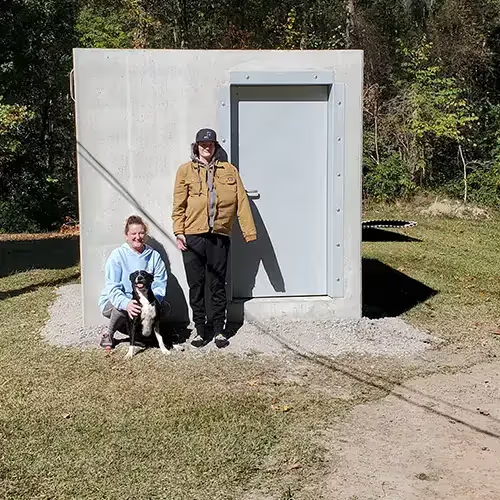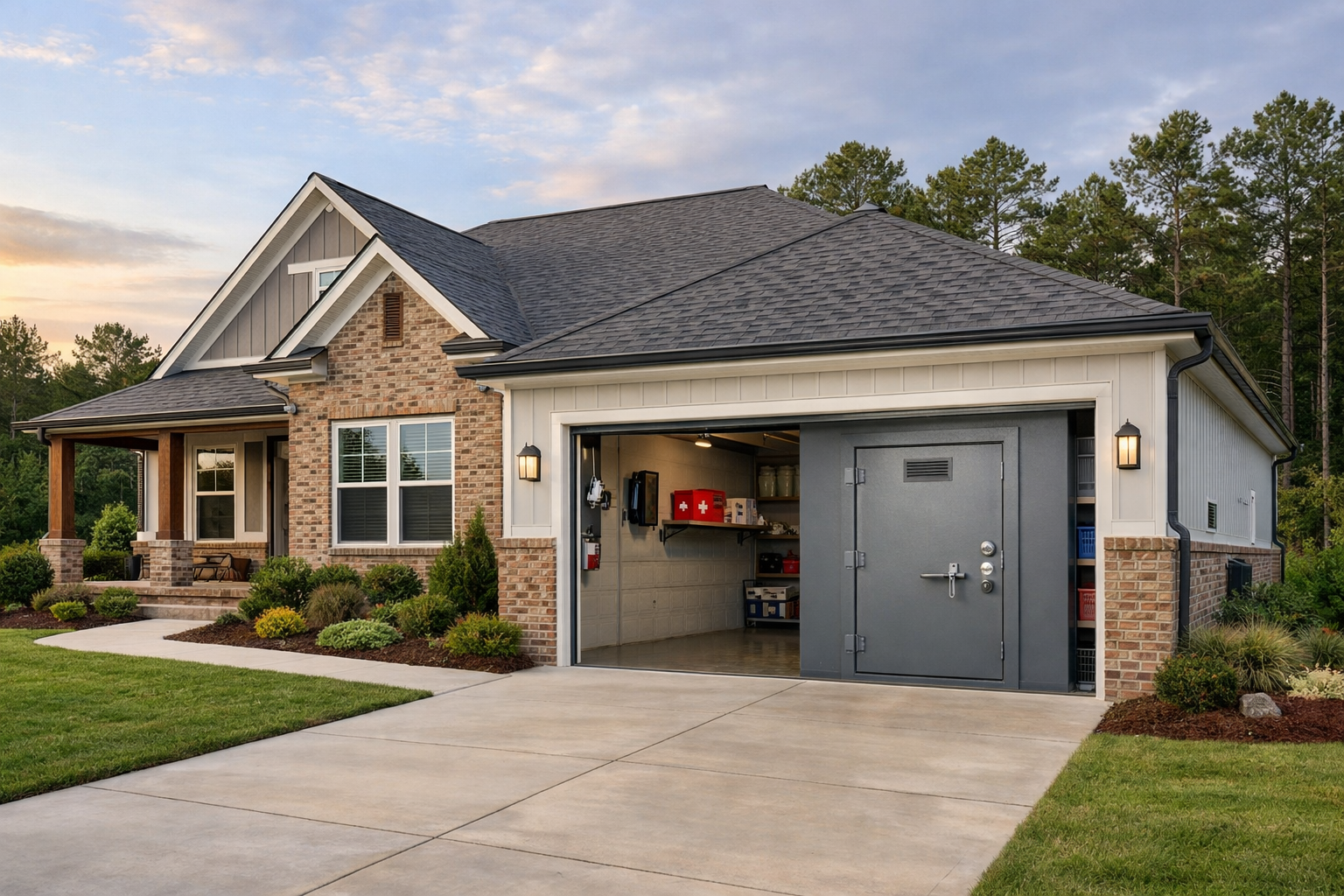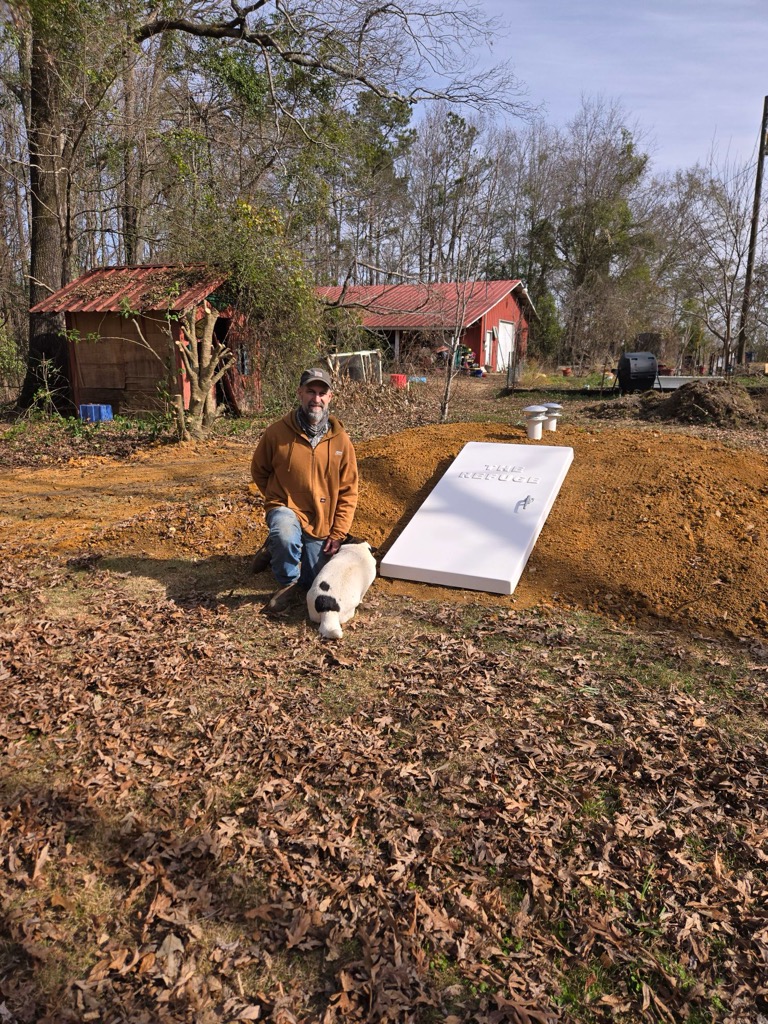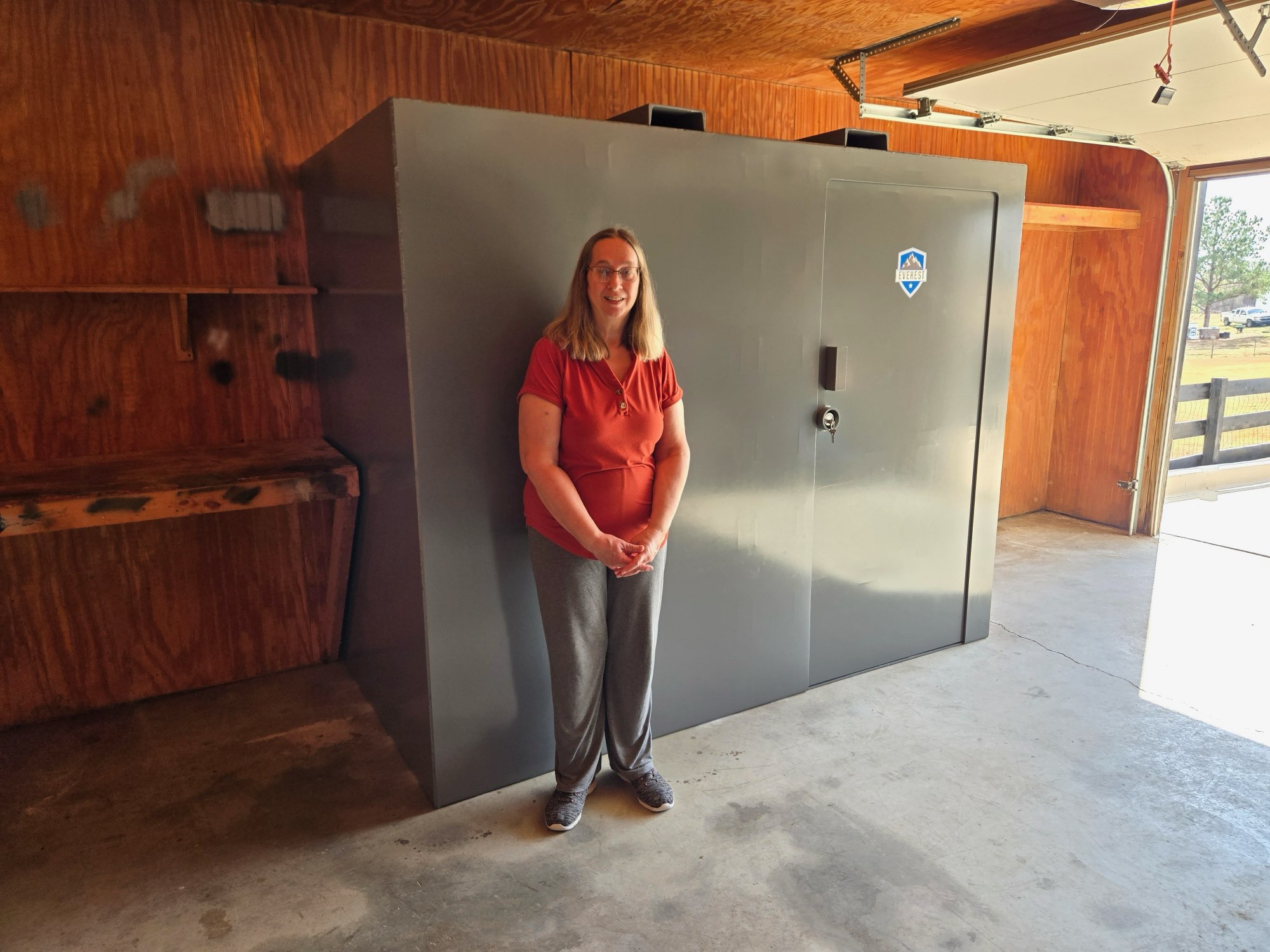Understanding Alabama Building Codes for Storm Shelters


When extreme weather strikes, a storm shelter in Alabama can be the difference between safety and disaster. Tornadoes, severe thunderstorms, and high winds are a regular threat in many areas, making a reliable shelter a critical investment. However, simply having a shelter isn’t enough — it must comply with Alabama building codes, FEMA standards, and all relevant local regulations to be truly effective and safe.
For homeowners, contractors, and builders alike, understanding the legal and structural requirements is essential. A qualified storm shelter must meet strict design, installation, and inspection criteria to ensure it can withstand extreme weather conditions. Compliance not only protects your family but can also make you eligible for valuable financial benefits, such as the Alabama storm shelter tax credit, Alabama storm shelter grant opportunities, and FEMA storm shelter grants Alabama.
By following the proper guidelines, you can ensure your shelter meets safety standards, qualifies for incentives, and provides the ultimate protection when it matters most.
Key Takeaways
- You must comply with state-specific Alabama building codes when constructing any qualified storm shelter in Alabama.
- Storm shelters qualify for tax credits or grants only if they meet strict safety and installation compliance standards.
- Knowing local requirements helps homeowners avoid costly mistakes during construction, acquisition, or installation of a compliant storm shelter.
- Alabama storm shelter dealers and contractors play a critical role in ensuring all storm shelters meet code requirements.
- A properly built storm shelter in Alabama can withstand extreme weather conditions and provide lasting peace of mind.
Alabama Building Codes and Storm Shelter Requirements
In Alabama, where tornadoes and severe storms are a frequent threat, having a qualified storm shelter is only part of the safety equation — it must also meet Alabama building codes, FEMA standards, and local regulations to be fully effective.
These rules apply to all types of shelters, including underground storm shelters in Alabama, above ground storm shelters Alabama, and garage storm shelters Alabama. Compliance not only ensures your shelter can withstand extreme weather but may also make you eligible for programs like the Alabama storm shelter tax credit or FEMA storm shelter grants Alabama. Understanding these codes is essential for homeowners, builders, and contractors aiming to protect lives and property.
Current Building Regulations for Storm Shelters
The Alabama building codes for storm shelters are in place to protect residents during tornadoes, hurricanes, and other severe storms. These rules ensure that underground and above ground storm shelters in Alabama are structurally sound, durable, and safe for long-term use. Whether in a backyard, garage, or integrated into a home, storm shelters must follow specific safety measures:
- Withstand high winds and flying debris.
- Support the weight of surrounding soil and additional loads.
- Provide proper ventilation and lighting.
Following these codes not only ensures your shelter can handle extreme weather but may also make you eligible for financial incentives such as the Alabama storm shelter tax credit, Alabama storm shelter grant, or storm shelter rebates Alabama. Compliance is essential for both protection and potential cost savings.
FEMA Standards and Compliance
FEMA standards represent the gold standard for qualified storm shelters in Alabama. Meeting these requirements is vital for safety and for qualifying for programs like FEMA storm shelter grants Alabama. A compliant storm shelter in Alabama must follow key FEMA safety measures:
- Structural strength to resist wind speeds from extreme storms.
- Strong anchoring to prevent movement.
- Adequate airflow for breathable air.
By following FEMA guidelines, homeowners add another layer of safety to their shelter beyond the minimum Alabama building codes. This applies to both above ground and underground storm shelters in Alabama. Additionally, FEMA compliance often helps homeowners meet the requirements for the Alabama storm shelter tax credit and other state or federal financial assistance programs.
Engineer Seal and Certification Requirements
All storm shelter installation in Alabama must include a licensed engineer’s seal. This certification confirms that the structure meets FEMA standards, Alabama building codes, and all relevant safety regulations. The certification process involves:
- Reviewing structural calculations.
- Verifying compliance with local and federal guidelines.
- Inspecting construction for adherence to approved plans.
Having an engineer’s seal is critical for both garage storm shelter Alabama and porch storm shelter Alabama installations. Without it, a shelter may not qualify for the Alabama storm shelter credit, storm shelter assistance Alabama, or certain grants. It also provides peace of mind that the shelter has been professionally reviewed for safety and durability.
Permit and Inspection Process
Before installing a garage storm shelter Alabama or porch storm shelter Alabama, homeowners must follow the permit and inspection process to ensure compliance. The process includes:
- Apply for a building permit.
- Submit engineered drawings and required documents to your county.
- Pass multiple inspections (pre-build, mid-build, and final).
These steps verify that the shelter meets Alabama building codes and FEMA standards, making it eligible for financial benefits such as the Alabama storm shelter tax credit 2025 or storm shelter rebates Alabama. Skipping any step can result in non-compliance, loss of eligibility for credits, and potential safety hazards.
Types and Installation of Storm Shelters in Alabama
Choosing the right storm shelter in Alabama is an important step in protecting your family from tornadoes, hurricanes, and other extreme weather events. Options range from underground storm shelters in Alabama to above ground safe rooms and storm shelter in garage floor Alabama units, each offering unique advantages.
The right choice depends on your property layout, accessibility needs, and budget. Proper installation is just as important as the type of shelter you select. Working with experienced storm shelter contractors in Alabama ensures compliance with Alabama building codes, FEMA standards, and eligibility for financial programs like the Alabama storm shelter tax credit or Alabama storm shelter grant. Understanding these options will help you make the best decision for your home’s safety and resilience.
Underground Storm Shelters
An underground storm shelter Alabama is one of the most secure options for protecting against tornadoes and other extreme weather events. These shelters are installed below ground, either in a backyard or under a garage floor, offering maximum protection from high winds and flying debris. They are typically constructed from reinforced concrete or steel to meet Alabama building codes and FEMA standards.
Benefits include:
- Enhanced security against tornado winds.
- Customizable designs to fit property space.
- Meets Alabama storm shelter credit eligibility when built to code.
Homeowners choosing this option should work with experienced storm shelter contractors in Alabama to ensure proper installation and compliance with all safety requirements, making them eligible for tax credits or grants.
Above Ground Safe Rooms
Above ground storm shelters in Alabama (also known as safe rooms) provide life-saving protection while being accessible to all household members, including the elderly and people with mobility challenges. Built with reinforced materials, these safe rooms are engineered to withstand high-wind events and meet FEMA standards.
Advantages:
- Easy accessibility for elderly or disabled family members.
- Compliance with storm shelter tax credit Alabama requirements.
- Can be disguised within your home’s design.
When constructed according to Alabama building codes, above ground shelters can qualify for the Alabama storm shelter tax credit or storm shelter grants Alabama. They are also a popular choice for homeowners seeking faster installation and interior integration without the need for extensive excavation.
Garage and In-Home Storm Shelters
A storm shelter in garage floor Alabama or an in-home unit provides immediate access without requiring you to step outside during dangerous conditions. These shelters are particularly valuable for quick entry during rapidly approaching storms. While they take up minimal space, they must still meet Alabama building codes and FEMA standards to qualify for the Alabama storm shelter credit or other assistance programs.
Benefits include:
- Quick access during severe weather.
- Can be customized to blend into your garage or home interior.
- Suitable for properties without space for an outdoor shelter.
Installation Considerations and Contractors
Selecting the right storm shelter contractors in Alabama is essential for ensuring your shelter is safe, compliant, and eligible for financial incentives. Always verify that your chosen installer understands Alabama storm shelter assistance programs and follows both state and FEMA guidelines.
Key steps when hiring include:
- Verify they understand Alabama storm shelter assistance programs.
- Request detailed cost estimates, including storm shelter Alabama cost.
- Ensure installation follows Alabama building codes and FEMA standards.
Working with an experienced contractor helps avoid costly mistakes, ensures eligibility for the Alabama storm shelter tax credit, and guarantees your shelter will perform when it matters most.
Alabama Storm Shelter Tax Credit Program
Installing a qualified storm shelter in Alabama not only provides life-saving protection during extreme weather but can also make you eligible for valuable financial incentives. The Alabama storm shelter tax credit — including the upcoming Alabama storm shelter tax credit 2025 — allows eligible taxpayers to claim an individual income tax credit for the construction, acquisition, or installation of a compliant shelter at their primary residence.
By meeting Alabama building codes, FEMA standards, and specific requirements from the Alabama Department of Revenue and Alabama Emergency Management Agency, homeowners can reduce their taxpayer liability while ensuring their shelter qualifies for additional programs, such as FEMA storm shelter grants Alabama and other government subsidies.
Eligibility Requirements
The Alabama storm shelter tax credit 2025 is designed to encourage homeowners to install safe, compliant shelters by offering an individual income tax credit. This benefit applies only to eligible taxpayers who add a qualified shelter to their primary residence. To qualify, the shelter must be installed by a licensed contractor and meet the requirements set by the Alabama Department of Revenue and the Alabama Emergency Management Agency. Additionally, it must be certified by a professional engineer to ensure it meets FEMA standards and Alabama building codes.
Requirements:
- Installed by a licensed contractor.
- Meets Alabama Department of Revenue and Alabama Emergency Management Agency guidelines.
- Certified by a professional engineer.
Following these rules ensures your shelter not only provides safety but also meets all criteria for the Alabama storm shelter credit or other related incentives.
Application Process and Required Documentation
To claim the Alabama tax credit for storm shelter, homeowners must follow a specific application process and submit all required documentation. The credit is only issued for the tax year in which the shelter is installed, and proof of compliance is mandatory.
Steps to claim the credit:
- Submit the tax credit certificate with your individual income tax return.
- Include proof of payment, contractor certification, and engineer seal.
- File in the tax year of installation.
Proper documentation ensures the credit is processed smoothly and helps avoid delays. Keeping a complete set of receipts, contracts, and certification paperwork will also assist in verifying that the shelter meets qualified storm shelter requirements under Alabama building codes and FEMA standards.
Credit Limitations
While the Alabama storm shelter credit offers valuable savings, there are important limits to consider. The credit can only reduce the taxpayer’s tax liability to zero balance — it is non-refundable, meaning it will not generate a refund. The statewide tax credit cap is set (e.g., two million dollars collectively), so applications are processed on a first-come, first-served basis. Additionally, any costs reimbursed by other government subsidies, such as grants or rebates, cannot be included when calculating the credit amount.
Credit limitations:
- The credit reduces your taxpayer’s tax liability to zero but is non-refundable.
- Cannot exceed the statewide tax credit cap (e.g., two million dollars collectively).
- Any costs reimbursed by other government subsidies are excluded.
Understanding these rules will help homeowners plan financing and ensure they maximize their available tax benefits.
Costs and Financial Assistance for Storm Shelters
Installing a storm shelter in Alabama is a smart investment in safety, but understanding the storm shelter Alabama cost is essential before starting your project. Prices can vary based on design, size, and whether you choose an underground or above ground storm shelter Alabama.
Fortunately, there are several ways to make shelters more affordable, including the Alabama storm shelter tax credit, Alabama storm shelter grant programs, FEMA storm shelter grants Alabama, and even storm shelter rebates Alabama through local initiatives.
Homeowners can also explore storm shelter financing Alabama options to spread costs over time. By combining financial assistance programs with proper planning, you can protect your family without breaking your budget.
Average Storm Shelter Costs
How much does a storm shelter cost in Alabama? Prices vary depending on size, materials, location, and features. Basic models, often small prefabricated units, range from $3,000–$6,000. Mid-range shelters with reinforced construction, ventilation systems, and additional safety features typically cost $6,000–$12,000. Fully customized or large-capacity shelters can cost $10,000–$15,000 or more.
Average cost ranges:
- Basic models: $3,000–$6,000.
- Mid-range: $6,000–$12,000.
- Custom builds: $10,000–$15,000+.
While costs may seem high, investing in a qualified storm shelter that meets Alabama building codes and FEMA standards not only protects your family but can also make you eligible for the Alabama storm shelter tax credit, grants, or other assistance programs.
Grants, Rebates, and Assistance
Financial help is available for residents through Alabama storm shelter grant programs, local initiatives, and federal funding. Counties may offer storm shelter rebates Alabama for compliant installations, while the FEMA storm shelter grants Alabama program, such as the Hazard Mitigation Grant Program, can provide significant assistance for eligible projects.
Options include:
- Alabama storm shelter grant programs.
- Storm shelter rebates Alabama through county initiatives.
- FEMA storm shelter grants Alabama via the Hazard Mitigation Grant Program.
- How to get a free storm shelter in Alabama online through nonprofit or local emergency management campaigns.
Checking with the Alabama Emergency Management Agency and local authorities is the best way to learn about current opportunities. These programs can reduce the total cost and make shelters more accessible for homeowners.
Financing Options
For those who don’t qualify for grants or need additional funding, storm shelter financing Alabama solutions can make installation more affordable. Manufacturers may offer payment plans, allowing costs to be spread out over time. Homeowners can also consider using home equity loans or securing financing through local banks.
Financing options:
- Manufacturer payment plans.
- Home equity loans.
- Local bank financing.
Financing not only helps manage storm shelter Alabama cost but also ensures you can install a qualified storm shelter without delay. By combining financing with available grants, rebates, or the Alabama storm shelter tax credit, homeowners can significantly reduce their out-of-pocket expenses while ensuring their shelter meets safety requirements.
Conclusion: Protecting Your Home with a Code-Compliant Storm Shelter
Following Alabama building codes ensures your storm shelter in Alabama is safe, durable, and eligible for tax credits or grants.
A code-compliant shelter—whether underground, above ground, or in-garage—provides security during extreme weather and may qualify for the Alabama storm shelter tax credit. By working with storm shelter companies in Alabama that understand FEMA standards, you can protect your family and maximize available financial benefits.
Frequently Asked Questions
1. How much does a storm shelter cost in Alabama?
Costs range from $3,000 for basic units to over $15,000 for large, custom shelters.
2. Can I get a free storm shelter in Alabama?
Some residents qualify for storm shelter assistance Alabama or grants for storm shelter Alabama through FEMA or local programs.
3. What is the Alabama storm shelter tax credit?
It’s a statewide program allowing eligible taxpayers to reduce their individual income tax when they install a qualified storm shelter at their primary residence.
4. Do above ground storm shelters qualify for the tax credit?
Yes — as long as they meet Alabama building codes and FEMA standards.
5. Where can I find storm shelter dealers in Alabama?
You can contact licensed storm shelter dealers in Alabama who are familiar with local regulations and credit programs.




